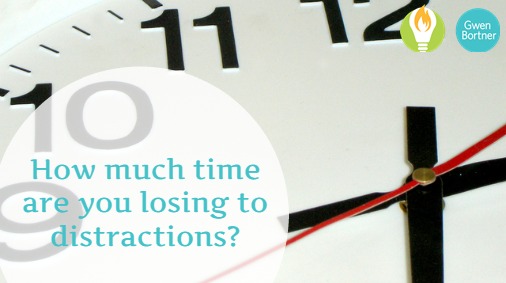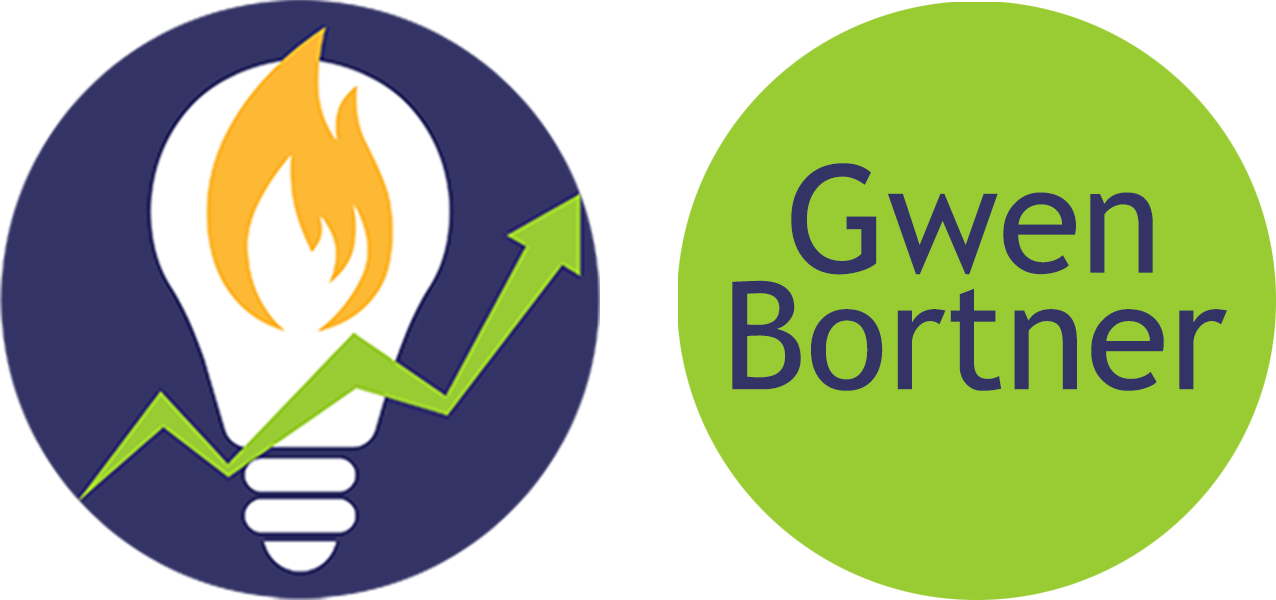
by Gwen Bortner | Office Productivity
You start your day feeling excited about a project you’re going to work on for your business. You start working, and after a little while one of two things might happen:
-
You get stuck on an idea and you’re not sure where to go with it; OR
-
You get some sort of interruption in the middle of your working time (email alert, phone ringing, your kid needs something, etc.)
Is this scenario familiar to you? What happens NEXT?
Understand your losses
At this point, you fall down a rabbit hole of distraction. You check your email, answer the phone, browse Facebook “to get some ideas,” or even just get up and switch the laundry or start lunch because you think you need a break.
You are actively working against your own success.
You have lost time, twice:
- The first amount is the time it took you to actually give in to that distraction (20 minute phone call, 30 minutes on Facebook, 10 minutes checking email, etc.).
- The second amount is the time you lost switching back and forth between two tasks; this is the actual time your brain takes to catch back up when you force it into a state of context switching.
Though you might understand the first loss, it’s my guess that you didn’t even realize you were losing that second block.
Get clear.
This table illustrates Todd Herman’s research on context switching:

No matter how much time you have to complete any given task, you automatically lose more than half of it just by adding another task into that time frame. The extra 20% goes to your brain, to allow it to mentally shift gears. As you can see, adding more tasks doesn’t grow in even amounts; the amount of time you lose to context switching increases exponentially every time you add another task.
Let’s say you have one hour to write a blog post. If you give in to 5 interruptions during that hour, you’ll actually only get 3 minutes to work on that blog post out of the whole hour, and you’ll lose 48 minutes of it to context switching. No wonder it feels like you never have enough time to do your work!
Improve your Focus.
How can you solve the problem of context switching?
Make it a habit to turn off your phone, close your browsers, and tell your family members not to interrupt unless there’s an emergency when you’re working. Give yourself the time you need in order to really do your work, and you’ll be amazed at how much more time you feel like you have, because you didn’t lose it to context switching!
How will YOU give yourself the time and space you need to get your work done? If you’d like a weekly reminder to focus on your priorities and take action to move you toward your goals, sign up below for my Weekly Course of Action e-mails. Let’s tackle this, together.

by Gwen Bortner | Office Productivity
These days, people treat multitasking like it’s a special talent; if you’re good at doing multiple things at once then that must make you a valuable and productive worker, right? Actually, that’s completely wrong.
Multitasking isn’t making us more productive; in fact, it’s doing exactly the opposite. According to INC, multitasking leads us to:
- a 40% drop in productivity
- 50% more time taken to accomplish a single task
- 50% more errors made while doing that task
So even though it may feel like you’re accomplishing more (because you’re working on more than one thing), you’re actually losing quite a bit of productivity when you focus on more than one thing at a time.
The Curse of Creativity
So many of us who lean toward the creative side of things seem drawn to multitasking. It’s not as much fun to focus on one thing at a time when there are so many (new! shiny!) distractions everywhere! Even in our personal hobbies, we often have multiple projects going at any given time, because it’s more interesting to start something new than to slog through something you’ve been working on for a while.
Context Switching
Though we often refer to it as multitasking, the real culprit here is context switching. The idea is that your brain is moving back and forth between thought processes or activities, even if technically you’re only working on one thing. For example: you’re writing a blog post, but your phone dings in the middle of it to let you know you’ve got a message on Facebook, so you stop to check that, and while you’re there you see an ad for those new shoes you’ve been wanting, and by the time you look at the clock you realize you’ve just wasted 30 minutes doing nothing at all.
Do you frequently find yourself jumping from one thing to the next, or are you able to remain focused on one task until it’s as complete as it can be in the moment? Read on for tips on how to increase your productivity by eliminating context switching from your daily routine.
Tips to Minimize Context Switching
- Block out your time. Set aside time for the things that take up time in your day: work tasks, personal or home-related tasks, and even things like checking email or browsing social media. You may tell yourself you’re “not going to check Facebook” during your working time, but let’s face it: you’re doing it anyway. By setting aside “Facebook time” on your calendar, you’re giving yourself permission to do that activity, but during the appropriate time for it.
- Keep your To Do list short. On any given day, you should have a list of no more than three important tasks you want to complete that day. By doing this you can give yourself the time you need to really devote your attention to those tasks, but if you overload your list with too many To Dos, you’ll feel tempted to work on them simultaneously or to switch between them before really completing anything, just to be able to say you worked on each item that day.
- Turn off the distractions. Our phones are like a window to the world outside, but they’re also a pipeline to distraction. You don’t NEED to be notified of every social media post, email, or even text message at any given minute of the day. If there’s a real emergency, someone will pick up the phone and actually call you. Turn off notifications on your phone during working hours, and make sure you don’t have any alerts on your computer.
- Get off the Internet. Having multiple tabs open while you’re working makes it too easy to just “click over for a minute” to check on a website that might distract you from your work. Cut out random Internet browsing during your work time. If you need to maintain a social media presence for your business, try to remember that you’re there for business – post to your own profile or group, but don’t get distracted reading other peoples’ posts.
Bonus “hack” for Facebook: set your Facebook page up so that it only shows you the groups you’re using for work or business, and hides all your personal feeds. That way you can check in for work and check back out again without getting distracted by photos of your best friend’s baby or your cousin’s dinner plate.
What’s the biggest “distraction trap” for you when you’re trying to be productive? Just knowing the answer to that question is the first step in avoiding that distraction in the future!
Would you like to train yourself to focus on what’s most important, and to work on the things that make the most difference in your life and business?
Join us in May for the Small Biz Book Club, where we’ll be reading Greg McKeown’s book, Essentialism. You’ll get a lot of great insights on how to improve your productivity and reduce distraction. Click here for all the details, or sign up using the box below:





